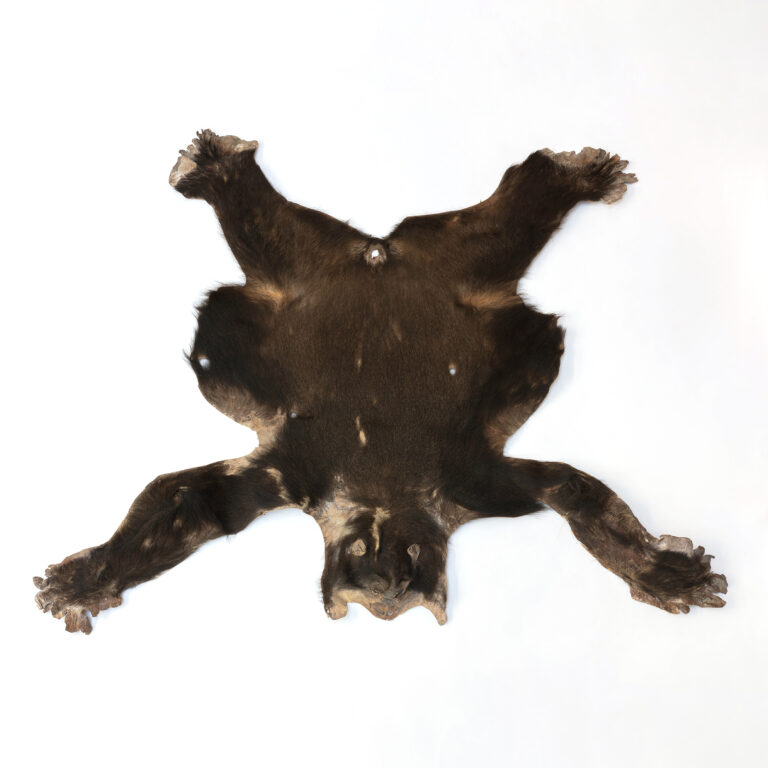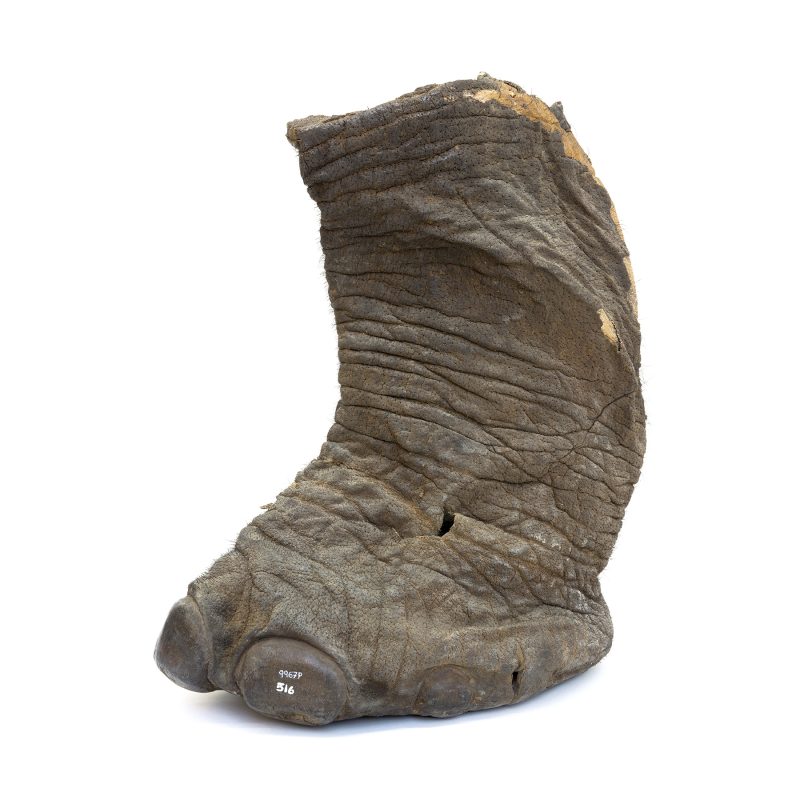Summary of results
The gorilla skin belongs to the museum’s general collection. It is in a good state of preservation and is currently in the museum building’s light storage room. We know from the museum’s inventories that it was donated by Jordi Sabater Pi, but there is no further information about the context of acquisition or the date. The Igualada Leather Museum, despite having a very small collection of colonial origin (twelve pieces of Guinean origin and twenty-one from Morocco), came to have an active colonial section until the 1960s, driven by the initiative of Jordi Sabater Pi himself (who was a member), a context that explains the existence of this piece and others in the collection. Even so, we know from secondary archives—such as that of Jordi Sabater Pi—that this piece arrived in 1957, along with seven other skins acquired in Equatorial Guinea, and that the hunter Lluís de Lassaletta was also involved in this donation. This is recorded in a certificate of collaboration with the institution issued in the name of Sabater Pi on 20 June 1957.
The skin was exhibited for the first time at the stand of the tanners’ guild of the Igualada industry located in the Leather Industry Hall of the Barcelona Fair, being this guild the one who made the treatment of the skin on behalf of the museum (probably the person in charge was Mr. Vilarrubies, who was the usual specialist of the museum). The exhibition of this skin at the fair was reported in some newspapers, such as La Vanguardia. As with the other skins, and because of the date of shipment, the piece can be linked to the network formed by Antoni Jonch, August Panyella, Sabater Pi, and Lluís de Lassaletta around the project of the Bindung Acclimatization Centre (Ikunde). With the argument of the scientific purposes of the institution, they were able to continue with the hunting and exploitation of animal species despite the progressive legislative limitations established in 1953 due to the risk of extinction of species.
Chronological reconstruction of provenance
The museum’s inventory does not record the date of entry, but from the documentation in Jordi Sabater Pi’s archive we know that it arrived around June 1957. In that year the grounds of the Bindung Acclimatization Centre were already being prepared, and the shipment could possibly have left from this site. In fact, at that time (April 1957) we can place the proposal of Lluís de Lassaletta, as an animal supplier, to the Barcelona City Council, regarding the provision of services and collaboration with the Bindung Acclimatization Garden.
Estimation of provenance
There is no information on where the specimen was hunted, nor on the intermediaries who sold it, who intervened in the transaction or who donated it, but a possible starting point would be Bindung (fifteen kilometres from Bata). The Bindung Acclimatization Garden was a project of August Panyella and Antoni Jonch, administered by Jordi Sabater Pi, which began to be planned in 1952, when the shipment of animals from the colony through Jonch and his circles became commonplace.
In this context, an alliance began to be established with the Barcelona City Council to open a centre for zoological experimentation that should facilitate shipments. Ikunde, as it came to be called, was officially inaugurated in 1958, but we know from Panyella’s correspondence in the MuEC archive that the grounds had been operational since March 1957. In any case, there is no archival data to confirm this hypothesis.
Possible alternative classifications
–
Complementary sources
Archives:
Museu Etnològic i de les Cultures del Món: MEB L128_47_02_04, Caixa 27. Carpeta 1. Subcarpeta 2, Carta d’A. Panyella a F. Ruiz, 12 de març de 1957. Jardí de Bindung i MEB L128_45_04, Caixa 26. Carpeta 1. Subcarpeta 4, documents relacionats amb el Sr. Lassaletta, 1958-59. Jardí de Bindung.
Arxiu Jordi Sabater Pi_CRAI Universitat de Barcelona: B.4.1.1.2 /317. Correspondència Sabater Pi amb el Museu de la Pell d’Igualada, al Fons Sabater Pi de la UB, lligall B.4.1.1.2
Arxiu General de l’Administració de l’Estat (AGA). Ref: caixa 81/11526, expediente de caza; 81/8134, permisos de caza.
Bibliography:
Antebi, A. et al. (2016). Ikunde. La petjada barcelonina en l’espoli colonial. Dins Andrés Antebi et al., Barcelona, metròpoli colonial (p. 187-220). Barcelona: Ajuntament de Barcelona.
Sant, J. i Gargallo, E. (2021). El petit imperi: Catalans a la colonització de la Guinea Espanyola. Barcelona: Angle.
Reyné Vergeli, J. M. (2023). Ikunde: Animals salvatges de la Guinea Espanyola per al Zoo de Barcelona. Actes d’història de la ciència i de la tècnica, 16, 95-117.


